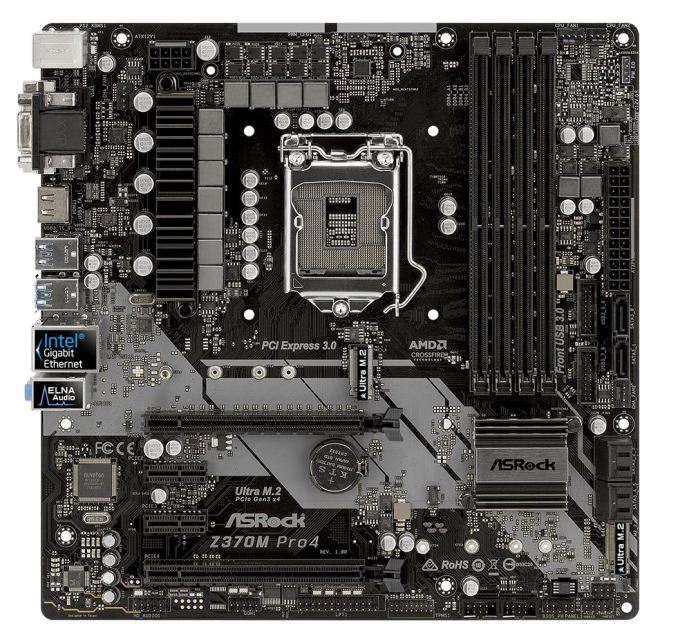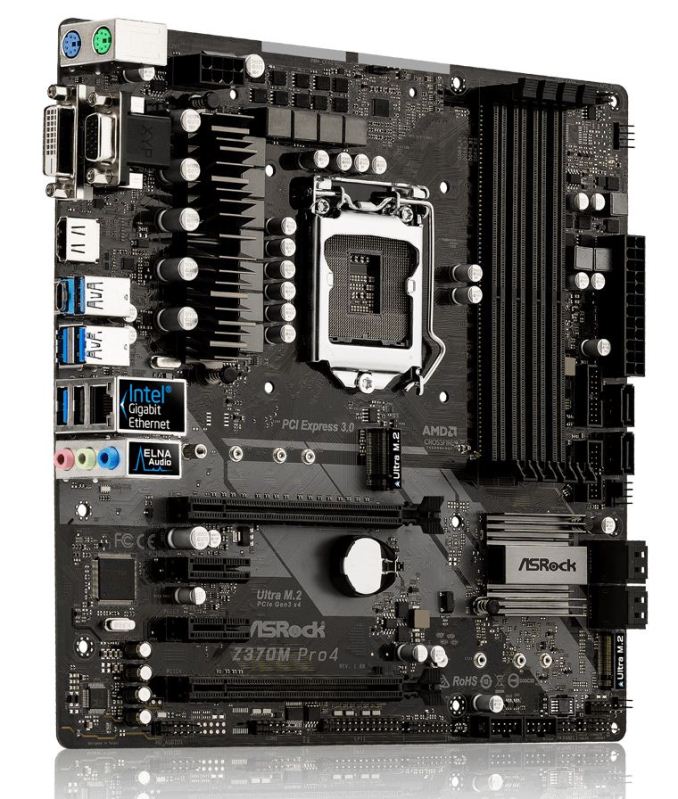Analyzing Z370 for Intel's 8th Generation Coffee Lake: A Quick Look at 50+ Motherboards
by Ian Cutress, Anton Shilov, Joe Shields & Gavin Bonshor on October 20, 2017 2:00 PM ESTASRock Z370M Pro4
The last few boards from ASRock will be of the small form factor variety. We normally do not see too many options in this space, especially close to the chipset launch. ASRock got a head start with shrinking the ATX sized Pro4 to the micro-ATX format and calls it the Z370M Pro4. The Z370M Pro4 uses the same power delivery setup as the full-sized twin, albeit on a shorter board. Even though its smaller in size, there are two full-length PCIe slots as well as two M.2 slots. It looks to have very similar features, just in a smaller package.
For aesthetics, a gray color runs across the board from the top of the audio section through the PCIe area and past the chipset to the edge of the board. The chipset heatsink gets much smaller on the micro-ATX version due to the less free real estate on the smaller board. Outside of that, we get the same single VRM heatsink, the same capacitors, and the same vanilla appearance. Users will not find an RGB LED on the board, nor a header to add one.
Even in mATX form, we get four memory slots which handle up to 64GB, with a rated supported speed up to DDR4-4300. There are two full-length PCIe slots, the first from the CPU at x16 and the second from the chipset at x4, and two open-ended x1 slots to round out PCIe connections.
Six SATA ports can be found on the board, with four mounted horizontally and two vertically a bit further up the board. All the SATA ports support RAID 0, 1, 5, and 10. The Z370M Pro4 also has two M.2 slots, with both able to fit an 80mm module. The first M.2 slot is SATA only while the second supports PCIe. Due to lane sharing, if the first M.2 socket is occupied by a SATA type M.2 device, SATA 0 will be disabled.
The board has four fan headers, two for the CPU (1 x 3-pin, 1 x 4-pin) and two 4-pin chassis fan connectors that auto-detect if a three or four pin fan is in use. Audio duties are taken care of by the Realtek ALC892 codec and uses ELNA audio caps. Network support is handled by a single Intel I219-V GbE. Thunderbolt support is not found on the Z370M Pro4.
USB support on the back panel consists of four USB 3.1 (5 Gbps) Type-A ports and one Type-C port. Additionally, there is one USB 2.0 port. The rest of the back panel IO contains separate PS/2 ports for mouse and keyboard, D-Sub/DVI-D/HDMI video outputs, Intel gigabit Ethernet, and the three-jack audio stack.













83 Comments
View All Comments
weevilone - Wednesday, October 25, 2017 - link
Notable that though the new boards are often very similar to their Z270 predecessors, Asus has dropped Thunderbolt 3 support from the Maximus X Hero board.masouth - Thursday, October 26, 2017 - link
ASUS ROG Z370 Maximus X Hero"....new metallic heat sinks that are an upgrade over the plastic heatsinks found on the Z270 version"
Please excuse my ignorance because I didn't own a ROG Z270 mb but...plastic HEAT SINKS? Not shrouds or decoration over a heat sink but the actual heat sinks themselves? That's either wrong, they performed their job pretty poorly, or plastic resins have advanced a lot farther in thermal conductivity (and cost for such) than I realized.
flowrush - Sunday, November 19, 2017 - link
"The other main distinguishable feature is the inclusion of integrated 802.11ac Wi-Fi with an antenna (that can only be described as a shark fin) found on the F."The above is incorrect in the article. The integrated Wi-Fi module with antenna is found on the E not the F.
Coldgame - Saturday, November 25, 2017 - link
I'm looking to build a rig with the Z370 Gaming ITX/ac, a GTX-1070 card and an Apple Thunderbolt Display.The review states:
"The key difference in the support between the two boards is going to be the Thunderbolt 3 port on the Gaming-ITX. This port supports video outputs..."
So, can anyone confirm or deny that video generated by the GTX-1070 can be output through the onboard Thunderbolt 3 port?
hanselltc - Sunday, December 3, 2017 - link
Looking forward to low-middle end mITX choices from this platform. It'll probably be paired with a 8100/8300 and be my secondary machine.Roen - Sunday, February 4, 2018 - link
Where are the 10 Gbps ports on the back? They all look like 5 Gbps ports, even the Type C.rbarak - Wednesday, February 21, 2018 - link
Is anyone using the Z370-P on Linux with two screens?I built a new machine based on the Z370-P, and both the DVI and the HDMI connected screens show the same image, and the RHEL7 setup/displays show only one Unknown Display.
I follwed the advice on stackexchange, and added this line:
$ grep GRUB_CMDLINE_LINE_DEFAULT /etc/default/grub
GRUB_CMDLINE_LINE_DEFAULT="i915.alpha_support=1"
Then I did:
sudo grub2-mkconfig -o "$(readlink /etc/grub2.conf)"
And rebooted, but still, the two displays are not shown.
dromoxen - Wednesday, May 9, 2018 - link
Shocked to see that both the Asrock mitx boards are "szie=ATX" .. LOLThe addition of Tunderbolt sure seems to add a hefty premium £120 vs £160 , luckily I can do without.
Kroebo - Sunday, October 7, 2018 - link
Sadly, I discovered that the ZUG Gaming PLUS doesn't support SLI.trag - Tuesday, January 15, 2019 - link
On the ASrock Z370M Pro4 the M.2 slot information is backwards. Both slots support NVME. One slot also supports SATA. As written, "The first M.2 slot is SATA only while the second supports PCIe." it seems to say that one slot is SATA only and the other slot is PCIe (NVME) only.